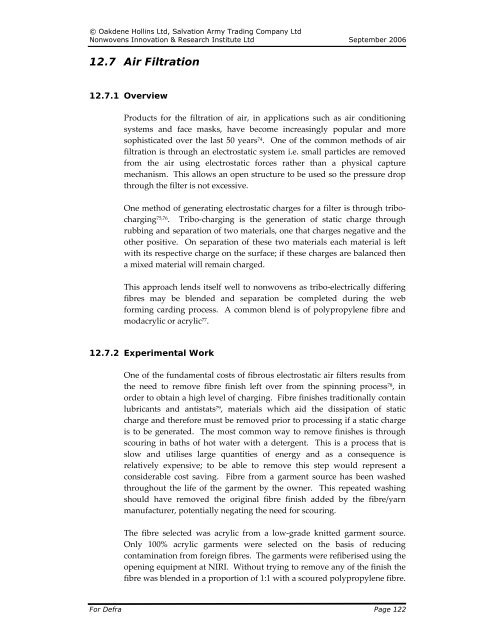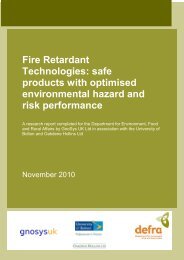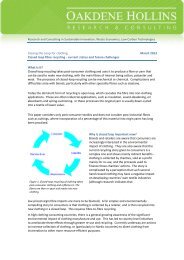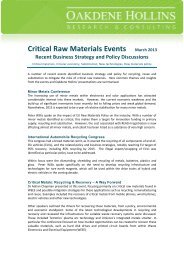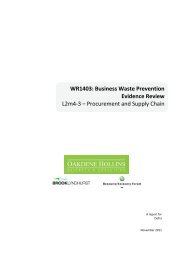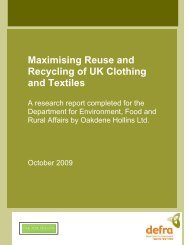Recycling of Low Grade Clothing Waste - Oakdene Hollins
Recycling of Low Grade Clothing Waste - Oakdene Hollins
Recycling of Low Grade Clothing Waste - Oakdene Hollins
Create successful ePaper yourself
Turn your PDF publications into a flip-book with our unique Google optimized e-Paper software.
© <strong>Oakdene</strong> <strong>Hollins</strong> Ltd, Salvation Army Trading Company Ltd<br />
Nonwovens Innovation & Research Institute Ltd September 2006<br />
12.7 Air Filtration<br />
12.7.1 Overview<br />
Products for the filtration <strong>of</strong> air, in applications such as air conditioning<br />
systems and face masks, have become increasingly popular and more<br />
sophisticated over the last 50 years 74 . One <strong>of</strong> the common methods <strong>of</strong> air<br />
filtration is through an electrostatic system i.e. small particles are removed<br />
from the air using electrostatic forces rather than a physical capture<br />
mechanism. This allows an open structure to be used so the pressure drop<br />
through the filter is not excessive.<br />
One method <strong>of</strong> generating electrostatic charges for a filter is through tribocharging<br />
75,76 . Tribo‐charging is the generation <strong>of</strong> static charge through<br />
rubbing and separation <strong>of</strong> two materials, one that charges negative and the<br />
other positive. On separation <strong>of</strong> these two materials each material is left<br />
with its respective charge on the surface; if these charges are balanced then<br />
a mixed material will remain charged.<br />
This approach lends itself well to nonwovens as tribo‐electrically differing<br />
fibres may be blended and separation be completed during the web<br />
forming carding process. A common blend is <strong>of</strong> polypropylene fibre and<br />
modacrylic or acrylic 77 .<br />
12.7.2 Experimental Work<br />
One <strong>of</strong> the fundamental costs <strong>of</strong> fibrous electrostatic air filters results from<br />
the need to remove fibre finish left over from the spinning process 78 , in<br />
order to obtain a high level <strong>of</strong> charging. Fibre finishes traditionally contain<br />
lubricants and antistats 79 , materials which aid the dissipation <strong>of</strong> static<br />
charge and therefore must be removed prior to processing if a static charge<br />
is to be generated. The most common way to remove finishes is through<br />
scouring in baths <strong>of</strong> hot water with a detergent. This is a process that is<br />
slow and utilises large quantities <strong>of</strong> energy and as a consequence is<br />
relatively expensive; to be able to remove this step would represent a<br />
considerable cost saving. Fibre from a garment source has been washed<br />
throughout the life <strong>of</strong> the garment by the owner. This repeated washing<br />
should have removed the original fibre finish added by the fibre/yarn<br />
manufacturer, potentially negating the need for scouring.<br />
The fibre selected was acrylic from a low‐grade knitted garment source.<br />
Only 100% acrylic garments were selected on the basis <strong>of</strong> reducing<br />
contamination from foreign fibres. The garments were refiberised using the<br />
opening equipment at NIRI. Without trying to remove any <strong>of</strong> the finish the<br />
fibre was blended in a proportion <strong>of</strong> 1:1 with a scoured polypropylene fibre.<br />
For Defra Page 122


